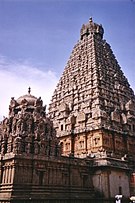Gingee Nayak Kingdom | |||||||||||||
|---|---|---|---|---|---|---|---|---|---|---|---|---|---|
| 1509–1649 | |||||||||||||
 | |||||||||||||
| Capital | Gingee Fort | ||||||||||||
| Common languages | Tamil, Telugu | ||||||||||||
| Government | Governors under the Vijayanagara Empire Monarchy | ||||||||||||
| King | |||||||||||||
| History | |||||||||||||
• Established | 1509 | ||||||||||||
• Disestablished | 1649 | ||||||||||||
| |||||||||||||
| Part of a series on |
| History of Tamil Nadu |
|---|
 |
The Nayaks of Gingee (Senji) were Telugu rulers of the Gingee principality of Tamil Nadu between 16th to 18th century CE.[1] The Gingee Nayaks had their origins in the Balija warrior clans of present-day Andhra Pradesh.[2] They were subordinates of the imperial Vijayanagara emperors, and were appointed as provincial governors by the Vijayanagar Emperor who divided the Tamil country into three Nayakships viz., Madurai, Tanjore and Gingee. Later, after the fall of the Vijayanagara's Tuluva dynasty, the Gingee rulers declared independence. While they ruled independently, they were sometimes at war with the Tanjore neighbors and the Vijayanagara overlords later based in Vellore and Chandragiri. Gingee ruler Surappa nayaka had a brother called Era Krishnappa Nayak whose son established himself in Karnataka and his family came to be known afterwards as the Belur Nayakas.[3]
- ^
- Sonti Venkata Suryanarayana Rao, ed. (1999). Vignettes of Telugu Literature: A Concise History of Classical Telugu Literature. Jyeshtha Literary Trust. p. 55.
- George Michell, ed. (1995). Architecture and Art of Southern India: Vijayanagara and the Successor States 1350-1750. Cambridge University Press. p. 13. ISBN 978-0-521-44110-0.
- Jennifer Howes, ed. (2003). The Courts of Pre-Colonial South India: Material Culture and Kingship. Routledge. p. 62. ISBN 978-1-135-78996-1.
- ^
- David Dean Shulman, Velcheru Narayana Rao, ed. (2020). Classical Telugu Poetry. University of California Press. p. 57. ISBN 9780520344525.
..... in the Tamil country, where Telugu Balija families had established local Nāyaka states (in Senji, Tanjavur, Madurai, and elsewhere) in the course of the sixteenth century.
- Sanjay Subrahmanyam (2001). Penumbral Visions: Making Polities in Early Modern South India. University of Michigan Press. p. 198. ISBN 9780472112166.
- Joseph Jerome Brennig, ed. (1987). The Textile Trade of Seventeenth Century Northern Coromandel: A Study of a Pre-modern Asian Export Industry. University of Wisconsin-Madison. p. 65.
- Muzaffar Alam, ed. (1998). The Mughal State, 1526-1750. Oxford University Press. p. 35. ISBN 978-0-19-563905-6.
As an arrangement, the Golconda practice in the first half of the seventeenth century was quite similar in crucial respects to what obtained further south, in the territories of the Chandragiri ruler, and the Nayaks of Senji, Tanjavur and Madurai. Here too revenue-farming was common, and the ruling families were closely allied to an important semi-commercial, semi-warrior caste group, the Balija Naidus.
- Indira Malapaka, ed. (2021). Telugu Inscriptions In Karnataka A Socio Cultural Study. Sri Venkateswara University. p. 96.
The nayaks of Madurai, Tanjore and Ginjee belonged to the balija caste.
- David Dean Shulman, Velcheru Narayana Rao, ed. (2020). Classical Telugu Poetry. University of California Press. p. 57. ISBN 9780520344525.
- ^ Noboru Karashima (2002). A Concordance of Nayakas: The Vijayanagar Inscriptions in South India. Oxford University Press. p. 35. ISBN 9780195658453.